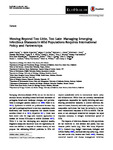Moving Beyond Too Little, Too Late: Managing Emerging Infectious Diseases in Wild Populations Requires International Policy and Partnerships
| dc.contributor.author | Voyles, J | |
| dc.contributor.author | Kilpatrick, AM | |
| dc.contributor.author | Collins, J | |
| dc.contributor.author | Fisher, M | |
| dc.contributor.author | Frick, W | |
| dc.contributor.author | McCallum, H | |
| dc.contributor.author | Willis, CR | |
| dc.contributor.author | Blehert, D | |
| dc.contributor.author | Murray, K | |
| dc.contributor.author | Puschendorf, Robert | |
| dc.contributor.author | Rosenblum, E | |
| dc.contributor.author | Bolker, B | |
| dc.contributor.author | Cheng, T | |
| dc.contributor.author | Langwig, K | |
| dc.contributor.author | Lindner, D | |
| dc.contributor.author | Toothman, M | |
| dc.contributor.author | Wilber, M | |
| dc.contributor.author | Briggs, C | |
| dc.date.accessioned | 2020-08-24T11:56:51Z | |
| dc.date.available | 2020-08-24T11:56:51Z | |
| dc.date.issued | 2014 | |
| dc.identifier.issn | 1612-9202 | |
| dc.identifier.issn | 1612-9210 | |
| dc.identifier.uri | http://hdl.handle.net/10026.1/16183 | |
| dc.description.abstract |
Emerging infectious diseases (EIDs) are on the rise due to multiple factors, including human facilitated movement of pathogens, broad-scale landscape changes, and perturbations to ecological systems (Jones et al. 2008; Fisher et al. 2012). Epidemics in wildlife are problematic because they can lead to pathogen spillover to new host organisms, erode biodiversity and threaten ecosystems that sustain human societies (Fisher et al. 2012; Kilpatrick 2011). There have been recent calls for large-scale research approaches to combat the threats EIDs pose to wildlife (Sleeman 2013). While it is true that developing new analytical models, diagnostic assays and molecular tools will significantly advance our abilities to respond to disease threats, we also propose that addressing difficult problems in EIDs will require considerable shifts in international health policy and infrastructure. While there are currently international organizations responsible for rapidly initiating and coordinating preventative measures to control infectious diseases in human, livestock, and arable systems, there are few comparable institutions that have the authority to implement transnational responses to EIDs in wildlife. This absence of well-developed infrastructure hampers the rapid responses necessary to mitigate international spread of EIDs. | |
| dc.format.extent | 1-4 | |
| dc.format.medium | Print-Electronic | |
| dc.language | en | |
| dc.language.iso | en | |
| dc.publisher | Springer US | |
| dc.subject | Agriculture | |
| dc.subject | Animals | |
| dc.subject | Animals, Wild | |
| dc.subject | Communicable Diseases, Emerging | |
| dc.subject | Cooperative Behavior | |
| dc.subject | Internationality | |
| dc.subject | Livestock | |
| dc.subject | Public Policy | |
| dc.title | Moving Beyond Too Little, Too Late: Managing Emerging Infectious Diseases in Wild Populations Requires International Policy and Partnerships | |
| dc.type | journal-article | |
| dc.type | JOUR | |
| plymouth.author-url | http://dx.doi.org/10.1007/s10393-014-0980-5 | |
| plymouth.issue | 3 | |
| plymouth.volume | 12 | |
| plymouth.publication-status | Published | |
| plymouth.journal | EcoHealth | |
| dc.identifier.doi | 10.1007/s10393-014-0980-5 | |
| plymouth.organisational-group | /Plymouth | |
| plymouth.organisational-group | /Plymouth/Faculty of Science and Engineering | |
| plymouth.organisational-group | /Plymouth/Faculty of Science and Engineering/School of Biological and Marine Sciences | |
| plymouth.organisational-group | /Plymouth/REF 2021 Researchers by UoA | |
| plymouth.organisational-group | /Plymouth/REF 2021 Researchers by UoA/UoA06 Agriculture, Veterinary and Food Science | |
| plymouth.organisational-group | /Plymouth/Users by role | |
| plymouth.organisational-group | /Plymouth/Users by role/Academics | |
| dc.publisher.place | United States | |
| dcterms.dateAccepted | 2014-01-01 | |
| dc.rights.embargodate | 2023-9-29 | |
| dc.identifier.eissn | 1612-9210 | |
| dc.rights.embargoperiod | Not known | |
| rioxxterms.versionofrecord | 10.1007/s10393-014-0980-5 | |
| rioxxterms.licenseref.uri | http://www.rioxx.net/licenses/all-rights-reserved | |
| rioxxterms.type | Journal Article/Review |


